CURRENT PROTECTION
Of all the dry forest areas on the islands of Fiji, there is only one, Yadua Taba, that is protected under national law. Similarly, very few species have conservation plans on the national level to protect them. As a result, Fiji's tropical dry forest, along with its rich and endemic flora and fauna, are still heavily threatened by overgrazing from livestock, clearing for land use, exotic and invasive species, and fires. Despite this lack of protection under government law, there are still a couple of ways the beautiful dry tropical forests of Fiji can be conserved.
- "Take nothing but pictures, leave nothing but footprints, and waste nothing but time," is a common phrase used to describe ecotourism and its common partnership with conservation. In the past few years there has been an increase in ecotourism in some of Fiji's dry tropical forests which can help in increasing the popularity of these regions, hopefully encouraging the Fijian government to see the value in conserving these areas.
- Spreading local awareness may also help in the conservation of these forests. According to a UCLA group of Geography students and faculty who did research on the dry tropical forests of Fiji, posters were distributed to schools in Fiji to educate the students on the flora found in these forests in an effort to raise awareness of conservation. Conservation efforts must begin at a local level and grow in order to be effective, it is important to show the people how valuable the preservation of these forests are; for the benefit of the country, the individual, and future generations.
Yadua Taba Island
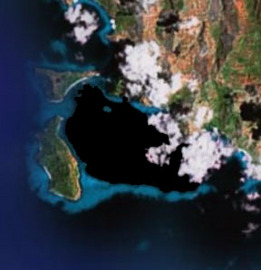
Yadua Taba left
©geog.ucla.edu/tdfpacific/fiji
Yadua Taba, a 7 square kilometer island located to the west of Vanua Levu, is the only location in Fiji where tropical dry forest is protected. In 1980, the National Trust of Fiji established Vanua Taba as Fiji's first wildlife sanctuary. As a result of this protected status, over the past 25 years the tropical forest has increased in its extent and overall conditions have greatly improved. Throughout those 25 years goats have been removed from the island, fires have been banned and other anthropogenic activities have been greatly restricted. Yadua Taba is also the only area that legally protects the largest population of the critically endangered Fijian crested iguana (Morrison et. al, 2009).
Although Yadua Taba’s population of their crest iguana is thriving and stable, it is still very vulnerable to introduction of invasive predators, disease, wildfire and exotic, alien plant species. Natural hazards like tropical cyclones can also contribute in decimating the population. Because this critically endangered species is almost exclusively restricted to dry forested areas, it has led to more research on the Fijian tropical dry forests. More information has been collected to monitor future tropical dry forest reforestation of regeneration on Yadua Taba as well as provide essential ecological data for future iguana translocation programs. Hopefully this will also lead to the study and protection of other dry forest regions in Fiji.
Although Yadua Taba’s population of their crest iguana is thriving and stable, it is still very vulnerable to introduction of invasive predators, disease, wildfire and exotic, alien plant species. Natural hazards like tropical cyclones can also contribute in decimating the population. Because this critically endangered species is almost exclusively restricted to dry forested areas, it has led to more research on the Fijian tropical dry forests. More information has been collected to monitor future tropical dry forest reforestation of regeneration on Yadua Taba as well as provide essential ecological data for future iguana translocation programs. Hopefully this will also lead to the study and protection of other dry forest regions in Fiji.
Eradication of an Invasive Species
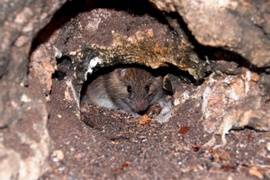
Courtesy of birdlife.org
Although protection of Fiji’s tropical dry forests have not been extensive, success stories from other conservation initiatives can hopefully set a precedent. From 2003 to 2005, the BirdLife International Fiji Programme conducted research to identify sites important for Fiji’s biodiversity. They identified 12 Important Bird Areas and in 2003 rediscovered the endemic Long-legged Thicketbird, which had not been seen for 108 years. However, searches still continue for the elusive Red-throated Lorikeet. With funding from the Darwin Initiative and the Australian Government’s Regional Natural Heritage Programme in 2006 enabled work to continue at six priority forest IBA sites, where they met with land owners. They consulted with the landowners about the protection of their forests for the survival of specific site-endemic birds and to advance towards the establishment of community-managed protected areas. In January of 2007, the Programme began two 2-year projects to identify and restore islands important for seabirds through the eradication of invasive alien species, mainly rats.
Two years after the Programme implemented the plan to eradicate rats from the Ringgold Islands, all seven islands have been confirmed rodent-free. Monitoring showed that people and other wildlife, as well as the birds, were benefitting from removal of the invasive pests. They were ruining the local people’s plantation crops and food stores as well as the islands unique biodiversity. The BirdLife staff is continuing to work with the Fijian people to make sure that the pests do not return.
It is clear that it has only been in recent years that great efforts have been made to protect Fiji’s diminishing forests. The success story of turning an island rat-free should hopefully set a precedent for other Fijian islands. The goal to remove invasive species on Vatu-i-Ra had seabirds in mind, but as more information of the importance of tropical dry forests and its great endangerment of its endemic species comes to light, perhaps greater strides can be taken towards the eradication of its invasive species and to help ensure conservation.
Two years after the Programme implemented the plan to eradicate rats from the Ringgold Islands, all seven islands have been confirmed rodent-free. Monitoring showed that people and other wildlife, as well as the birds, were benefitting from removal of the invasive pests. They were ruining the local people’s plantation crops and food stores as well as the islands unique biodiversity. The BirdLife staff is continuing to work with the Fijian people to make sure that the pests do not return.
It is clear that it has only been in recent years that great efforts have been made to protect Fiji’s diminishing forests. The success story of turning an island rat-free should hopefully set a precedent for other Fijian islands. The goal to remove invasive species on Vatu-i-Ra had seabirds in mind, but as more information of the importance of tropical dry forests and its great endangerment of its endemic species comes to light, perhaps greater strides can be taken towards the eradication of its invasive species and to help ensure conservation.
What is CITES?
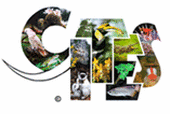
CITES is the Convention on International Trade in Endangered Species of Wild Fauna and Flora. It is an international agreement between governments, drafted at a meeting of the International Union for Conservation of Nature (IUCN). Its aim is to ensure that international trade specimens of wild animals and plants does not threaten their survival and it assigns different degrees of protection to more than 33,000 species of flora and fauna. Appendix I of CITES includes 800 species that are threatened and can be affected by trade. It is illegal to trade species under Appendix I.
Species with Varying Degrees of Protection
The Fiji Crested Iguana
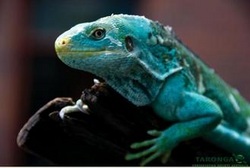
"The National Trust for Fiji is currently implementing the 2010 IUCN Species Recovery Plan for the Fijian Crested Iguana" (Taronga.org). The major threat to this species is habitat loss, mainly caused by the overgrazing done by herds of goats, so the conservation plan includes the translocation of the iguanas to new islands (Specifically, Yadua Taba), captive breeding, and the removal of goats from islands where the iguana populations are declining. The Taronga Conservation Society of Australia also plays an important role in working and training people in Fiji to help implement the IUCN Species Recovery Plan.
The Fiji Banded Iguana
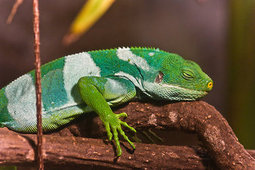
The biggest threat to this reptile species is habitat loss due to fires, storms, agricultural development, and competition for habitat with feral goats. They are also threatened by introduced predators such as rats, mongooses, and cats. The main conservation effort for this species is that it is listed on the CITES Appendix I.
The Fiji Ground Frog
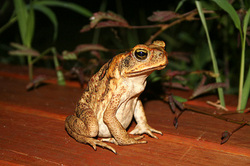
The Fiji Ground Frog is mainly threatened by habitat destruction as a result of invasive mongooses introduced around 1883. The Mongoose preyed heavily on this species of frog, eventually completely wiping out the populations wherever the mongooses went. Other species fed on the frogs as well such as the cane toad and cats, but they have been known to be able to survive with these predators around. Now the ground frogs only live on mongoose-free islands; however, their populations are still decreasing as their status is currently endangered. The number one conservation measure is the prevention of the spread of mongoose to the islands where this species is still able to survive. The Fiji Ground Frog lives in the Ravilevu Nature Reserve and Bouma Nautral Heritage Park, both of which are on Taveuni. Unfortunately neither region actively protect wildlife or enforces any laws of protection for these endangered amphibians.
The Fiji Tree Frog
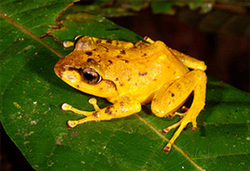
The Fiji Tree Frog is threatened by habitat loss caused by humans through small scale subsistence wood extraction and logging. It is listed as near threatened because its Extent of Occurrence is less than about 20,000 square kilometers, but it is still able to adapt and survive. One reason it may be threatened by habitat loss is that its clutch size (number of eggs the female releases while mating) averages only about 30 eggs and they actually live inside plants such as the common lily and giant Pandanus. The main conservation priority conservation effort for this species is the conservation of mature forest, especially along streams where this species commonly occurs.
Back to the Top
Sources
BirdLife Pacific, . "The Magnificent Seven (rat free Fijian islands)." BirdLife International Community. BirdLife, 2010. Web. 5 Jun 2011. <http://www.birdlife.org/community/2010/12/the-magnificent-seven-rat-free-fijian-islands/>.
Morrison, Clare, Gunnar Keppel, Nunia Thomas, Isaac Rounds, and Peter S. Harlow. "Critically endangered Fijian crested iguana (Brachylophus vitiensis) shows habitat preference for globally threatened tropical dry forest.." Pacific Science(2009): n. pag. Web. 5 Jun 2011. <http://www.highbeam.com/doc/1G1-196534665.html>.
Encyclo Online Encyclopedia. Yadua Taba. Web. 5 Jun 2011.
<http://www.encyclo.co.uk/define/Yadua%20Taba>
BirdLife Pacific, . "The Magnificent Seven (rat free Fijian islands)." BirdLife International Community. BirdLife, 2010. Web. 5 Jun 2011. <http://www.birdlife.org/community/2010/12/the-magnificent-seven-rat-free-fijian-islands/>.
Morrison, Clare, Gunnar Keppel, Nunia Thomas, Isaac Rounds, and Peter S. Harlow. "Critically endangered Fijian crested iguana (Brachylophus vitiensis) shows habitat preference for globally threatened tropical dry forest.." Pacific Science(2009): n. pag. Web. 5 Jun 2011. <http://www.highbeam.com/doc/1G1-196534665.html>.
Encyclo Online Encyclopedia. Yadua Taba. Web. 5 Jun 2011.
<http://www.encyclo.co.uk/define/Yadua%20Taba>
